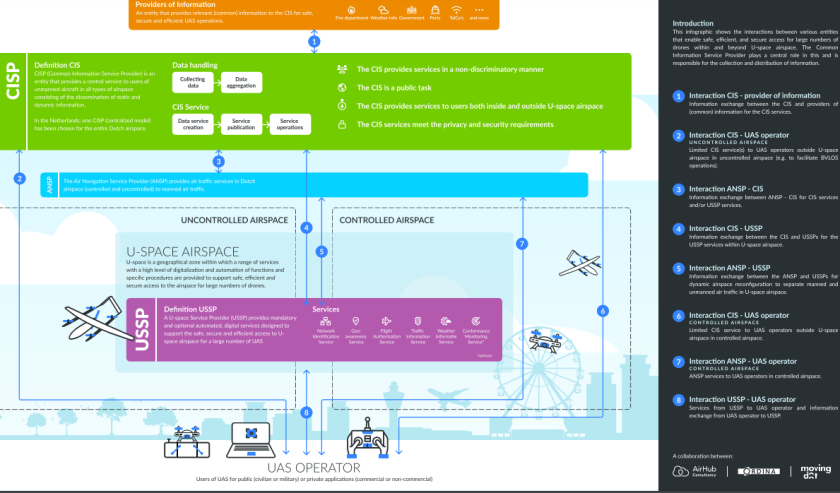AirHub Consultancy, in collaboration with partners Ordina and MovingDot, conducted a comprehensive study on behalf of the Dutch Ministry of Infrastructure and Water Management. The study delved into the fundamental U-space architecture, focusing specifically on the architecture of a Single Common Information Service Provider (CISP).
Objectives
The main objective was to create an architectural vision, business-, information- and security architecture for a centralized U-space ecosystem. The Dutch Ministry intends to utilize these outcomes as a foundational framework to establish the CISP in line with European and National standards and regulations, including stakeholder requirements.
About Ministry of Infrastructure and Water Management
The Ministry of Infrastructure and Water Management is committed to improving quality of life, access, and mobility in a clean, safe and sustainable environment. The Ministry strives to create an efficient network of roads, railways, waterways and airways, effective water management to protect against flooding, and improved air and water quality. Within the Ministry, the unmanned aviation program is an integral part, with the U-space implementation being one of its pillars. The unmanned aviation team asked AirHub Consultancy as the project leader and its partners to develop the framework architecture.
Dutch vision of a centralized U-space architecture
When designing the CIS, one can choose between a single national CIS for all U-space airspace or one CIS per U-space airspace. In both scenarios, information can be supplied by a single organization or through a distributed system where information is relayed directly from the provider to the users. However, the common information will have to be made available to the relevant and authorized actors at all times on a non-discriminatory basis, ensuring data quality and security. When designating a single Common Information Service Provider (CISP), the provider must meet the certification requirements specified by the European authority, EASA.
Initially, in the Netherlands, the decision was made to appoint a single CISP for all U-space airspace. This choice was driven by the need for data exchange within U-space and beyond, into (un)controlled airspace. The Ministry of Infrastructure and Water Management opted for a broader utilization of the CIS, recognizing its central role in sharing information within and outside U-space airspace, with the goal of ensuring safe and integrated use of airspace by both unmanned and manned air traffic.
Development of architecture
The development of the CIS followed the ‘The Open Group Architecture Framework’ (TOGAF) methodology, resulting in a clear framework and a methodical approach to the intricate Enterprise architecture of the CIS. To establish this framework, the architectural vision, business, information, and security architecture were developed and visually represented using ArchiMate by our partner Ordina. Furthermore, the architecture complies with the latest European standards and regulations, such as Implementing Regulation 2021/664, 665, and 666.
The architectural vision laid the foundation for the development of the CIS architecture. This vision defined the relationships between various stakeholders, both within and outside U-space, and identified the necessary capabilities of the CIS provider as an organization. Through stakeholder interviews, we identified the requirements of different stakeholders, including ANSP, Defense, and state operators. The vision also emphasized an extended CISP providing services outside U-space.
Alongside the architectural vision, the business and information architecture were created, and a security architecture was developed in parallel, following the ‘security by design’ approach.
International benchmarking
Besides the development of the architecture, we conducted an international benchmark with interviews with ANSPs and CAAs in other countries (e.g. FOCA, LFV). It became clear during the stakeholder interviews that a centralized architecture (Single CIS) is preferable to a distributed model. Important considerations here are that the CIS is seen as a national (critical) infrastructure where a single source of information is required. A public task is also a logical choice, in which the government provides basic needs/information. The quality and reliability of data in combination with (cyber) security is extra important in this centralized form to reduce the risk of a ‘single point of failure’ as much as possible.
Partly due to these considerations, EASA member states that have already made their choices decided to designate the national ANSP as a Single CISP.
Conclusion
The study concludes that the Single CISP model is a suitable choice. From a substantive perspective, we can conclude that the ANSP is the most logical choice, considering existing information flows and certification. Furthermore, offering services outside U-space is desirable, especially if these services enable UAS applications, such as BVLOS flights. It recommends that the Ministry further investigates the phasing of the CISP towards a national Single CISP and explores the types of services that can be provided outside U-space without conflicting with potential commercial (U-space) Service Providers.
For more information, please contact consultant Toby Enzerink who worked on this project together with partners Ordina and MovingDot.
For more information visit:




